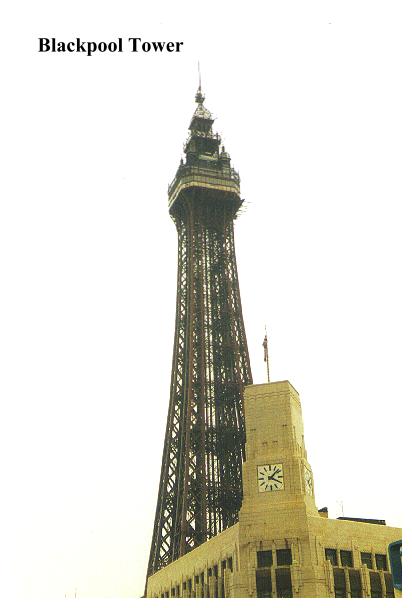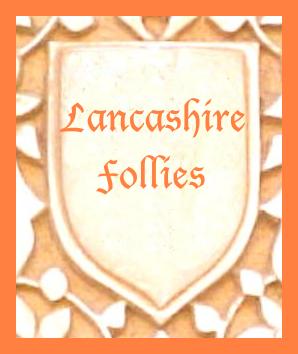10.BLACKPOOL TOWER
It is stating the obvious to say that Blackpool contains a most interesting and curious prospect tower. It is in fact, to quote its own advertising- 'Britain's Biggest, Boldest, Brightest and Best!' Need I say more?
Map ref: SD 305 361
Rating: Follies and General Interest ***
Blackpool is an old tart- gaudy, loud, brash, tasteless and above all 'for hire'. Grinning grotesquely she will relieve you of your cares- and your cash! What elemental force, what bizarre yearning can (after you have explored the wild and lonely places of this jewel of English counties) possibly draw the lover of peace and quiet to this seemingly soulless and godforsaken place??
The answer stands exactly 518 feet 9 inches above the flat Fylde countryside. Standing on the lonely summit of Clougha Pike, it beckons from across the marshes of the Wyre. It calls you from Darwen Tower, from Ashurst's Beacon and from distant Hampsfell Hospice across the sands of Morecambe Bay. From Formby Point (in the wake of Ince Blundell) You can see it shimmering in the haze along the endless flat sands, and from lonely Sambo's Grave it seems 'nobbut a cock stride away!'. From every point of Lancashire, north or south, high or low, one single image captures the imagination and draws it like a beacon. That beacon is Blackpool Tower.
Let's start at the beginning. At the turn of the eighteenth century, Blackpool was nothing more than a few fishermen's huts on the dunes of a lonely coast. Had it not been for the foibles of fashion, it would probably have remained that way, but fashion created Blackpool, and she has remained a dedicated follower ever since.
In the 1740s, Blackpool was 'discovered' by some adherents to the at-that time fashionable craze for sea bathing. They waxed lyrical about the health giving properties of the place, and soon others followed in their wake. In consequence, Blackpool gradually began to develop into a popular sea bathing resort. No doubt it would have remained a small but undistinguished spa town had it not been for one singular development in in 1840s - the coming of the railway.
The railway, a novel and cheap form of transport, brought in ordinary working class folk in pursuit of a good time. Their tastes were unsophisticated and frequently vulgar, and Blackpool wasted no time in pandering to them. In 1863 the North Pier was officially opened, and in 1868 the forerunner of the Central Pier was erected. By 1870 a promenade had been built, and the Winter Gardens, with its tea rooms, dance floors and opera house, had become a major attraction.
Blackpool Tower was the brainchild of John Bickerstaffe, Mayor of Blackpool and Director of the Blackpool Electric Tramways Company. It all began in the 1880s with a business trip to Paris, where Bickerstaffe marvelled at the Eiffel Tower which had been constructed for the Great Exhibition. Blackpool, he fancied, would look good with one of those, and on his return he set to work with a will. A Blackpool Tower Company was formed, consisting of five directors - Alderman John Dickins, a former Mayor of Salford, Wilfred Anderton of Preston, Arthur Lawcock of Whitchurch, William Bratby of Hale, Cheshire, and Bickerstaffe himself.
The Tower, designed by Maxwell and Tuke, was constructed on the site of Doctor Cocker's Aquarium and Menagerie.The aquarium was not demolished, but was incorporated into the complex, its turtles (amazingly) being the same ones that stare superciliously down at you today. The foundation stone of the Tower was laid on the 25th September 1891. The foundation contract was agreed at 3,000 pounds and the original tender to build the tower was 42,000 pounds, a phenomenal sum in those days. (And it was expected that the complex buildings would cost a further 36,000 pounds.)
The Tower Ballroom is magnificent and is a grade two listed structure. What the humble workers of Oldham and Rochdale must have thought of such Edwardian magnificence is surely a treat for the imagination. Dance around the Tower Ballroom to the strains of the mighty Wurlitzer Organ, made eternally famous by the great Reginald Dixon, and you are dancing through almost a century of history in the footsteps of departed generations.For all human life is here -love and laughter, sadness and despair, sickness, birth and death. Few places can have the atmosphere of the Tower Ballroom.
The Tower took three years to build. It was officially opened on the 14th May 1894, along with its ballroom and circus, and the world came to marvel at this manmade giant standing so high above the flat Fylde countryside.
And a giant it certainly is! Blackpool Tower contains 3,478 tons of steel and 352 tons of cast iron, each of its four huge legs rests on concrete blocks 35 feet square by 12 feet thick. The blocks are reinforced with girders and and the whole thing rests on boulder clay. Five million bricks were used in the construction. Maintenance of the "stick" is a constant headache for the twenty riggers, painters and welders whose job it is to preserve the Tower from the wind and the rain. Like the Forth Bridge, the Tower has to be continually repainted. In 1977,to celebrate Queen Elizabeth II's jubilee, it was briefly painted silver. There are four viewing levels on the top the Tower, accessed by iron newel staircases. The higher up you go, the more nervous you get! There is a fifth (ultra precarious!) level, but this is locked up. Notices threaten dire penalties for those throwing objects over the 'side' and rightly so!
Today the Tower reigns supreme in Blackpool, but it was not always so. The nearby Winter Gardens did not take too kindly to this upstart rival that was stealing their trade and resolved to hit back. This they did by constructing a giant Ferris wheel, modelled on the famous one in Vienna. This wheel was 240 feet hight (half the height of the tower!) and had thirty cars around its circumference, each capable of carrying thirty passengers. The so-called 'Battle of the Giants' began in 1896, when the big wheel began turning, but ultimately it was the Winter Gardens who were the losers. The trouble with a giant Ferris wheel is its slow speed and the phenomenal amount of time it takes to load it with passengers. The Blackpool wheel travelled at a half a mile per hour, which made it slow, time-consuming and generally boring. Ultimately it could not compete with the attractions of the tower and in 1928 it was finally dismantled, the cars being sold off at 13 pounds apiece. Eventually the Blackpool Tower Company purchased the Winter Gardens itself, and the spirit of competition was finally laid low.
From Blackpool Tower you return to the bright lights of the Golden Mile. Walking on the prom after dark you stand on the borderline between two worlds, on one side of you the illuminations, the noise, the clamour, the glitz, and on the other darkness and silence- save for the gentle lapping of the sea below the beach steps. It is in a sense, a microcosm of the two Lancashires - the one made by man and the other by nature. As in the Tower ballroom- All Life is here!








